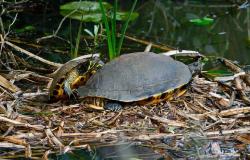
On the Zalkerdijk, near Zalk (Overijssel), along the IJssel, look out for a hank. I was here before, and then I paid attention to other things, but now I look with Albert Corporaal, ecologist and one of the authors of the Atlas of the IJsselspecifically to the elongated ponds or channels that lie more or less against the dike, with reed collars around them and strips of land in between, while the IJssel itself flows not too slowly through not too endless a landscape a little further on.
Hanken are dead river arms, arms that used to form the main course of the river for a while. From these hooks you can see what the course of the IJssel was like before people started determining the course of things.
About the author
Caspar Janssen prescribes de Volkskrant about nature, biodiversity and landscape.
Hanken no longer arise naturally, but until the 18th century rivers, and certainly the IJssel, were broad, meandering and in many places shallow and usually slow water flows, which were not bounded by dikes. At higher water levels and stronger currents, the river cut into the outer bends, which eroded. In the inner bends, where the current was less, sludge precipitated, causing them to land. This created an ever-larger loop. Eventually the moment came when the river cut through its own loop, cutting off the road between the starting point and the end point of the loop. The loop itself became a dead arm of the river, a hank.
That also happened here. The IJssel once ran along the west side of the village of Zalk, Corporaal points out, until the loop was broken and the river chose the east side. Now the course is fixed, through the canalization, through the deepening of the channel, through the dikes. Corporaal regrets this, deep in his heart he believes that it would be better if the IJssel were to regain its old, meandering course, that even dikes would disappear, but yes, then shipping would not be possible in the summer, and it would water meander into the surrounding polders for a few weeks in winter. “That is less bad than we now think,” says Corporaal. ‘Until the 18th century, people here simply lived with the water. They lived on mounds and farmers benefited from those floods, because the river deposited fertile silt. So free fertilization.’ Farmers even tried to hold on to the water as long as possible. ‘That will be important again, given the dry summers.’
Anyway, Corporaal knows that his wish is not realistic. We look at some more crannies, on either side of the river. I suddenly realize that I was skating for the first time on a hank, which in our country, along the Waal, was called strang. And that the Brabant village of Hank, where I often rented a boat to sail into the Biesbosch, is probably also named after a dead river arm.
We pause for a moment at the Vreugderijkerwaard, at a dug secondary channel, as part of the Room for Rivers project. A fake hank, actually. Just about the highest possible. And at the same time an example of how beautiful the river landscape can be.
Tags: hooks IJssel people started determining
-




